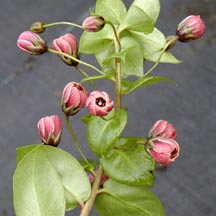
In the Garden![]()
Rick Barboza
Kolokolo kuahiwi
LATIN NAME
Lysimachia hillebrandii
Shrub’s flowers ideal for leis
Description: A sprawling shrub with dark green, oval leaves that have a pointed apex. New leaves tend to cluster toward the top of the stems, spacing out as the plant grows. The new branches, as well as the veins on leaves, are pinkish-red. As the branch becomes older, it will turn woody.
The flowers of this plant are most striking. They hang, facing downward, on stems that extend out past the leaves. Each flower is about three-quarters of an inch in diameter and light maroon with dark maroon veins on each petal. I've seen individual branches with more than 20 flowers on them, and they look awesome. The flowers will stay on the plant without losing their beauty for about a week, and sometimes longer.
HUI KU MAOLI OLA
Although this is a general description of this plant, don't be surprised if you see something different when hiking; they are highly variable, especially in leaf shape, leaf orientation and size. The only thing static is its flowers. There are also a couple of other native Lysimachia that resemble this species, found in the same type of habitat, so you really need to know your stuff in order to distinguish them from one another.
Distribution: This plant is not commonly seen, but is usually found in open areas of mesic to wet forests on the islands of Kauai, Oahu, Molokai, Lanai and Maui.
Cultural use: The longevity and unmatched beauty of the flowers make this an ideal plant for lei making.
Landscape use and care: You are fortunate if you have one of these plants for yourself; they look great just about anywhere. I suggest planting them in front of some sort of dark backdrop like a rock wall, green ti hedge or hapu'u ferns so that the flowers stand out when blooming.
These plants prefer full sun to light or partial shade, with daily watering in well-drained soil.
Few pests bother this plant, although I have seen scale on them. This can be controlled either by applying a systemic pesticide like orthene or opting for the more technical method of smooshing them with your fingers. Ants often bring the scales to the plants to harvest their sugary secretions, so once you smoosh the scales, look around for ants and get rid of them too, or they will bring back more scale and turn you into a scale-smooshing machine.
Also: The way kolokolo kuahiwi grows is similar to that of another more common coastal native plant, called pohinahina (Vitex rotundifolia); both are sprawling shrubs. But what you might not know is that another name for pohinahina is kolokolo kahakai. Kolokolo means "to crawl," which is how the plants grow -- by crawling along the ground. The second words are locality descriptors, kahakai meaning "beach" and kuahiwi meaning "mountain."
Rick Barboza co-owns Hui Ku Maoli Ola, a native Hawaiian plant nursery, with Matt Schirman. Contact him at 259-6580 or e-mail rickckbarboza@aol.com.
Gardening Calendar


